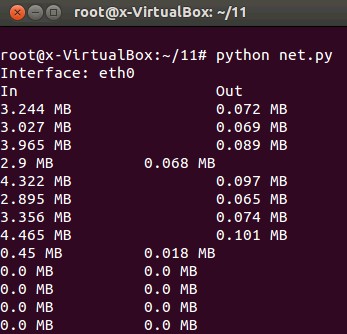linux系统使用python监测网络接口获取网络的输入输出
Jun 16, 2016 am 08:45 AMnet.py 获取网络接口的输入和输出
#!/usr/bin/env Python
import time
import sys
if len(sys.argv) > 1:
INTERFACE = sys.argv[1]
else:
INTERFACE = 'eth0'
STATS = []
print 'Interface:',INTERFACE
def rx():
ifstat = open('/proc/net/dev').readlines()
for interface in ifstat:
if INTERFACE in interface:
stat = float(interface.split()[1])
STATS[0:] = [stat]
def tx():
ifstat = open('/proc/net/dev').readlines()
for interface in ifstat:
if INTERFACE in interface:
stat = float(interface.split()[9])
STATS[1:] = [stat]
print 'In Out'
rx()
tx()
while True:
time.sleep(1)
rxstat_o = list(STATS)
rx()
tx()
RX = float(STATS[0])
RX_O = rxstat_o[0]
TX = float(STATS[1])
TX_O = rxstat_o[1]
RX_RATE = round((RX - RX_O)/1024/1024,3)
TX_RATE = round((TX - TX_O)/1024/1024,3)
print RX_RATE ,'MB ',TX_RATE ,'MB'
简单说明一下清单 4:清单 4 读取/proc/net/dev 中的信息,Python 中文件操作可以通过 open 函数,这的确很像 C 语言中的 fopen。通过 open 函数获取一个 file object,然后调用 read(),write()等方法对文件进行读写操作。另外 Python 将文本文件的内容读入可以操作的字符串变量非常容易。文件对象提供了三个“读”方法: read()、readline() 和 readlines()。每种方法可以接受一个变量以限制每次读取的数据量,但它们通常不使用变量。 .read() 每次读取整个文件,它通常用于将文件内容放到一个字符串变量中。然而 .read() 生成文件内容最直接的字符串表示,但对于连续的面向行的处理,它却是不必要的,并且如果文件大于可用内存,则不可能实现这种处理。.readline() 和 .readlines() 之间的差异是后者一次读取整个文件,象 .read() 一样。.readlines() 自动将文件内容分析成一个行的列表,该列表可以由 Python 的 for ... in ... 结构进行处理。另一方面,.readline() 每次只读取一行,通常比 .readlines() 慢得多。仅当没有足够内存可以一次读取整个文件时,才应该使用 .readline()。最后清单 4 打印出网络接口的输入和输出情况。
可以使用 Python 命令运行脚本 net.py 结果见图 4 

Heißer Artikel

Hot-Tools-Tags

Heißer Artikel

Heiße Artikel -Tags

Notepad++7.3.1
Einfach zu bedienender und kostenloser Code-Editor

SublimeText3 chinesische Version
Chinesische Version, sehr einfach zu bedienen

Senden Sie Studio 13.0.1
Leistungsstarke integrierte PHP-Entwicklungsumgebung

Dreamweaver CS6
Visuelle Webentwicklungstools

SublimeText3 Mac-Version
Codebearbeitungssoftware auf Gottesniveau (SublimeText3)

Heiße Themen
 Verwenden des Task-Managers unter Linux
Aug 15, 2024 am 07:30 AM
Verwenden des Task-Managers unter Linux
Aug 15, 2024 am 07:30 AM
Verwenden des Task-Managers unter Linux
 Lösen Sie das Problem der verstümmelten Anzeige von Grafiken und Diagrammen auf dem chinesischen Überwachungsserver Zabbix
Jul 31, 2024 pm 02:10 PM
Lösen Sie das Problem der verstümmelten Anzeige von Grafiken und Diagrammen auf dem chinesischen Überwachungsserver Zabbix
Jul 31, 2024 pm 02:10 PM
Lösen Sie das Problem der verstümmelten Anzeige von Grafiken und Diagrammen auf dem chinesischen Überwachungsserver Zabbix
 7 Möglichkeiten, wie Sie das Registrierungsdatum von Linux-Benutzern überprüfen können
Aug 24, 2024 am 07:31 AM
7 Möglichkeiten, wie Sie das Registrierungsdatum von Linux-Benutzern überprüfen können
Aug 24, 2024 am 07:31 AM
7 Möglichkeiten, wie Sie das Registrierungsdatum von Linux-Benutzern überprüfen können
 Erfahren Sie in 5 Minuten, wie Sie Schriftarten zu Fedora hinzufügen
Jul 23, 2024 am 09:45 AM
Erfahren Sie in 5 Minuten, wie Sie Schriftarten zu Fedora hinzufügen
Jul 23, 2024 am 09:45 AM
Erfahren Sie in 5 Minuten, wie Sie Schriftarten zu Fedora hinzufügen
 Was soll ich tun, wenn die fehlenden WPS-Schriftarten unter dem Linux-System dazu führen, dass die Datei verstümmelt wird?
Jul 31, 2024 am 12:41 AM
Was soll ich tun, wenn die fehlenden WPS-Schriftarten unter dem Linux-System dazu führen, dass die Datei verstümmelt wird?
Jul 31, 2024 am 12:41 AM
Was soll ich tun, wenn die fehlenden WPS-Schriftarten unter dem Linux-System dazu führen, dass die Datei verstümmelt wird?
 werfen! Ausführen von DOS auf Raspberry Pi
Jul 19, 2024 pm 05:23 PM
werfen! Ausführen von DOS auf Raspberry Pi
Jul 19, 2024 pm 05:23 PM
werfen! Ausführen von DOS auf Raspberry Pi
 So verbinden Sie zwei Ubuntu-Hosts mit einem Netzwerkkabel mit dem Internet
Aug 07, 2024 pm 01:39 PM
So verbinden Sie zwei Ubuntu-Hosts mit einem Netzwerkkabel mit dem Internet
Aug 07, 2024 pm 01:39 PM
So verbinden Sie zwei Ubuntu-Hosts mit einem Netzwerkkabel mit dem Internet
 So verbergen Sie Ihren Linux-Befehlszeilenverlauf
Aug 17, 2024 am 07:34 AM
So verbergen Sie Ihren Linux-Befehlszeilenverlauf
Aug 17, 2024 am 07:34 AM
So verbergen Sie Ihren Linux-Befehlszeilenverlauf







